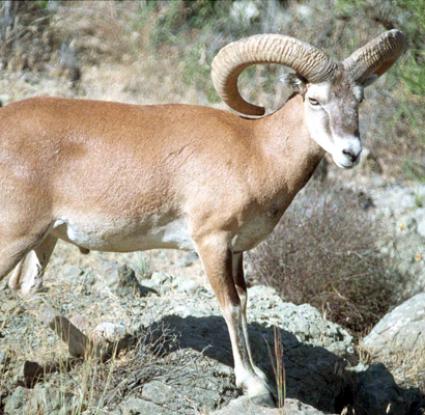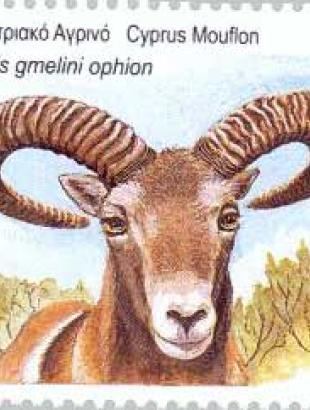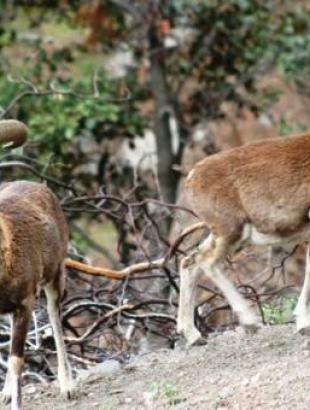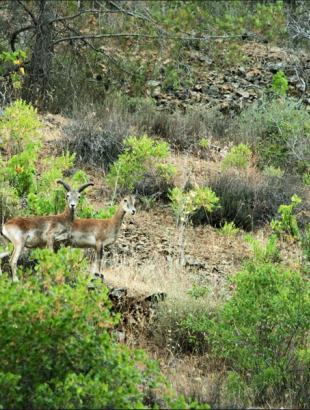Wild sheep of Cyprus.
Name - Origin
A species of wild sheep (Ovis orientalis ophion) found only in Cyprus (endemic species).
According to C. G. Yangoullis: άγριος ή αγρός (wild) + ending - ινός (-inos). He interprets the word as a species of Cyprus goat that lives freely in the forests of the Troodos mountains (Yangoullis 2009, entry αγρινόν,το, 37).
According to Xenophon P. Pharmakidis, it is a goat species that lives in the mountains of Kykkos (Kypri 1983 [2003²], entry αγρινόν,το, 50).
George Loukas in his Glossary mentions about mouflon (agrinon) that it is a wild animal, similar to a deer in speed and form, and to a sheep in other characteristics, and the people call it the sheep of Agios Mamas. Perhaps it is the animal which others call the wild beast. The goat of ancient times seems to differ from the mouflon, as many such animals reside in the mountains. The word is also used metaphorically for people who are unapproachable (Kypri 1979 [2002²], entry αγρινόν,το, 12).
The meat of the mouflon was usually roasted, cooked in a pot or preserved in salt (apohtin). It had no fat and was sweet like sugar regardless of the way it was cooked. After the animal's fourth year of age the meat would not be not consumed, since it was tough (Xioutas 1978, 163-168).
Additional information and bibliography
W. Von Boldensele (1333) mentions about the agrino: "In the mountains of Cyprus there is a wild goat with wool like sheep and dog, and it is said that it does not exist anywhere else and that its meat is sweet" (Xioutas 1978, 163-168).
George Loukas mentions that the wild goat lives remotely in the mountains and senses the hostile presence from afar, which is why it is never captured by hand. However, Cypriots often hunt it, as they hide in the mountains over it (Kypri 1979 [2002²], entry αγρινόν,το, 12).
In his Glossary, Xenophon P. Pharmakidis notes that agrino is an animal similar to the deer. In the past, ageing meat was considered 'delicious and sweet'. These animals were usually found in the mountains of Kykkos; their hunting was forbidden by the English Government because the number of animals had greatly decreased. A three-day permit was only granted in some cases, upon payment of a certain amount of money. During the period 1912-1925 that he was writing the Glossary, Pharmakidis mentions that the agrino began to extinct, that only now and then two or three are found, and that hunting them is very difficult (Kypri 1983 [2003²], entry αγρινόν,το, 50).
Agrino has been threatened with extinction several times. It is currently protected by the International Union for the Conservation of Nature and Natural Resources (note: Kyriaki Panteli).
Yangoullis K. G. (2009), Thesaurus of the Cypriot dialect. Interpretative, Etymological, Phraseological and Nomenclatural Dictionary of the Medieval and Modern Cypriot Dialect, Theopress Publications, Nicosia.
Kypri Th. D. (ed.) (1979 [2002²]), Materials for the compilation of a historical dictionary of the Cypriot dialect, Part A, Glossary of George Loukas, Publications of the Centre for Scientific Research, XLI, Nicosia.
Kypri Th. D. (ed.) (1983 [2003²]), Materials for the compilation of a historical dictionary of the Cypriot dialect, Part B, Glossary of Xenophon P. Pharmakides, Publications of the Centre for Scientific Research, IX, Nicosia.
Xioutas P. (1978), Cypriot animal folklore, Publications of the Centre for Scientific Research, XXXVIII, Nicosia.
Dimitra Demetriou, Stalo Lazarou, Kyriaki Panteli, Argyro Xenofontos






